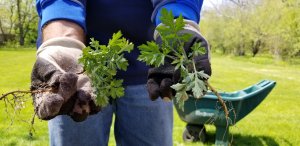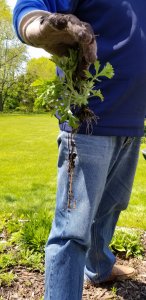Mugwort, wormwood – by either name, a real problem
September 9, 2020
Q. I am curious if you have an idea about a weed that grows in our yard every year. It spreads very rapidly, seems invasive and grows to a pretty high level as summer goes along. We have asked many people, and they are quite stumped. My wife does not like it, and we pull it and spray it, but it just keeps coming back, spreading and invading. Also, it seems to transplant to other parts of the yard when we transplant hosta. Any advice you have will be most welcomed! – J.A., Monticello, Indiana
A. This looks like it could be Artemisia vulgaris, more commonly known as mugwort or wormwood. It is considered an invasive species in several states and is included in the 2019 Indiana Terrestrial Plant Rule, which prohibits all sales and distribution of the plant. The weed is a perennial that spreads by both seed and rhizomes (underground horizontal stems), so it can spread quickly once established. The height of the plant can reach up to 5 feet if left undisturbed.
Control of this plant in established gardens is a challenge! Hand digging the plant will help, but any piece of the plant left in the soil can re-sprout. Repeated digging will be needed. Cutting and pulling can actually stimulate additional growth from the rhizomes. Even herbicides usually require several applications to control this plant. And any herbicide that would be effective against this weed would damage your garden plants, so spraying is not practical in established gardens. Targeting application by wicking or hand painting with broadleaf weed herbicides might provide some control if it can be done carefully to avoid any contact of the chemical with your desirable plants. Be sure to read and follow all label directions before applying any pesticide.
Category: Extension, Horticulture & Landscape Architecture
Tags: Invasive species, mugwort, wormwood

